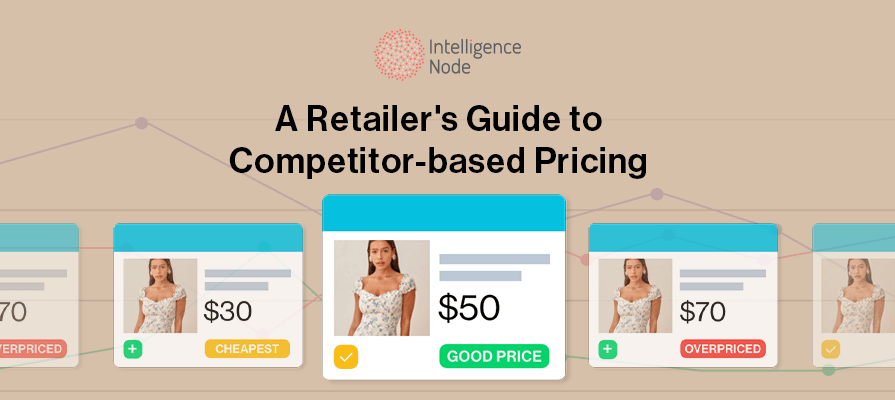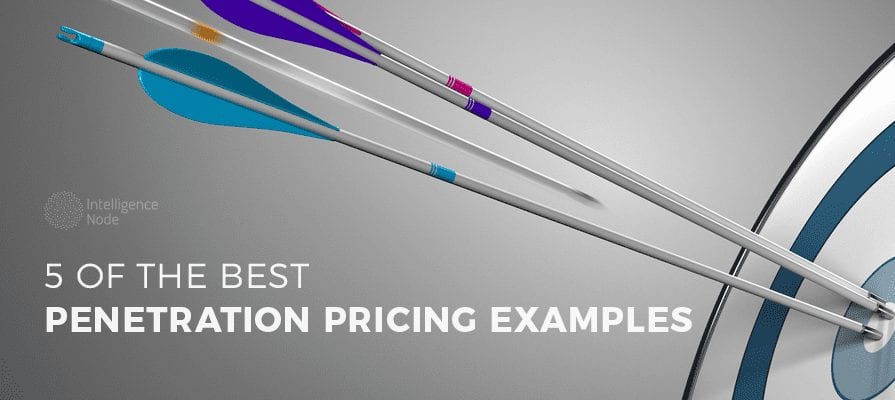Table of Contents:
What is a competitor-based pricing strategy
Examples of competitor-based pricing
Pros and cons of competitor-based pricing
How to build a competitor-based pricing strategy
Alternative pricing strategies
Final word David Wayne Wilson’s quote, “what I ‘charge’ today has nothing to do with yesterday or tomorrow. It has to do with ‘now’!” holds a valuable clue for pricing. You can consider umpteen factors to price your products and services, but if you don’t show customers how you fare against the competition and add value today, your sales goals will remain elusive.
In a hyper-competitive market where the shoppers always have the option to buy from somewhere else, it is crucial to price your products only after studying the competition. If you don’t match competitor pricing and buyer expectations, it will result in high cart abandonment rates and impact your bottom line significantly.
In this article, you will learn about competitor-based pricing and its pros and cons. You will understand its types and how it differs from alternative pricing strategies. Moreover, you will be able to judge if it suits your needs and identify steps to build your plan to compete in the market.
But before that, let’s start with the basics.
What is a competitor-based pricing strategy?
Competitor-based pricing or competitive pricing strategy is a method of pricing products by matching them against competitors in the market. Since lower price is often the topmost consideration for buyers, competitive pricing helps ensure you are on par with market players and a buying option for customers.
This strategy is prevalent in B2C commerce, where products share physical and digital shelves and battle for wallet share. Online retailers and marketplaces offer customers multiple options and detailed information on assortment and pricing to help shoppers pick the best product for their needs.
Image Source: Amazon
The competitor-based pricing strategy is especially popular with CPG brands like Pepsi and Coke that follow competitor movements closely to shift their prices. But competitive-based pricing is not only about offering the same or lower price than competitors. A lot depends on other factors like market trends and brand perception.
Also read on : Competitive Pricing Strategy – See How Products Are Priced
While lowering prices is one side of competitor-based pricing, a well-known market leader can remain unaffected by changing pricing trends. Conversely, it can leverage its brand image to go over and beyond the competitors. When a company routinely lowers its prices than others, it becomes the low-cost market leader. Walmart leads this camp with its successfully tested Everyday Low Price (EDLP) strategy.
Apple is on the other end.
Its brand is enough to create excitement around the latest releases and features. Its dedicated customer base perceives the products’ value and doesn’t think twice before spending a fortune. Remember, Apple is an exception and not the rule. Its success is a result of decades of hard work. Initially, you will need to price lower than competitors to build awareness and gain traction with your target audience.
Image Source: Apple
But underpricing your products or services can significantly impact your profit margins. While it’s a great tactic to boost sales immediately, it is not very lucrative from a long-term perspective. So, consider the different options before implementing the competitor-based pricing strategy.
Examples of competitor-based pricing strategies
A solid pricing strategy is built by carefully analyzing competitors, brand perception, market, and buyer preferences. Keep that in mind when going for one of the following options:
1. Price below competitor prices
It’s a strategy where new entrants price their products less than competitors to find traction and capture market share. A new cereal brand looking to penetrate the market will have to sell its products at lower prices or offer perks like discounts to persuade buyers to shift from costlier options like Kellogg’s.
2. Price match competitors
In this option, brands offer their products or services at the same price. It happens when two or more brands are located nearby or share digital shelves. Adjacent gas stations or eateries sell at the exact cost. Likewise, retail giants like Walmart and Amazon routinely match (and outdo) each other in price wars.
3. Price above competitor prices
It’s a strategy where businesses offer more (or better) features than competitors and price based off that. Here, the customers make buying decisions based on perceived value and don’t mind paying extra.
Sounds familiar?
Next, let’s cover the benefits and drawbacks of competitor-based pricing in detail.
Pros and cons of competitor-based pricing
A competitive pricing strategy comes with its fair share of benefits and drawbacks. Before we cover the bad, let’s look at the good:
It is dynamic
: This strategy doesn’t need a lot of research or analysis. You can use a retail analytics and competitive intelligence platform like Intelligence Node to detect market shifts and easily adjust your pricing.It is easy to implement
: Competitor-based pricing depends on competitors. You don’t need complex formulas or research to arrive at your rates. With a relatively easy analysis, you can benchmark yourself against multiple competitors.It is flexible and adjustable
: You can easily combine this strategy with other options. If you want to factor in production cost and value, competitor-based pricing can work with alternative pricing methods (more on this below) like a cost-plus strategy to help you arrive at the final price.It is safe
: Sometimes, new pricing strategies can fail to attract buyers or cause churn. With competition-based pricing, you reduce that risk and have a higher chance of building a dedicated customer base over time. It keeps you relevant and in the race for wallet share.
Competition-based pricing doesn’t work if you are against established names or incomparable business sizes. Remember these two biggest factors when crafting a competitor-based pricing strategy. Other cons you must keep in mind are:
It is unpredictable
: Small businesses may not have the budget to invest in a competitive intelligence tool or the resources to constantly monitor competition manually. It can be challenging to keep up with dynamic pricing.It can be rigid
: This strategy does not consider production cost, consumer demand, and product value. This isolates your products from other market factors and does not give a holistic view of the competitive landscape.It imposes uniformity
: You can’t differentiate your products based on value and benefits and blend in with the competition. It takes away the opportunity to make a case for why your products are on the higher end and how they serve buyers.
Image Source: Kohl’s
The bottom line is this: a competition-based pricing strategy is reactive. If you are a startup with limited resources, it can be risky to price your products based on competitors alone. You must explore alternative pricing strategies to make an informed decision before adopting it.
Alternative pricing strategies
Competitor-based pricing is only one option amongst many. You can choose other pricing strategies to balance your product value with profit depending on your business model and needs. These are:
1. Cost-plus pricing
A traditional (and easy) method, the cost-plus pricing strategy considers the production cost and adds a profit margin. While the strategy is relatively low-risk, it is not always the best method since it overlooks the product value, consumer appetite, and competitor prices.
2. Demand-based pricing
It’s a pricing strategy where the demand for a product determines its price. If the demand is high, so will be the price. This method can be tricky to implement because the seller does not always have a reliable way of gauging the demand unless they have expert insights from a retail analytics platform like Intelligence Node.
The eCommerce industry relies on this pricing method during special occasions and seasons when the demand is high for specific products. But with the rise of online cab services, where prices surge during peak times, it is also making big headway in that sector.
Image Source: Uber
3. Value-based pricing
Also known as customer-based pricing, this strategy relies on customer perception to price products. You adopt an outward look instead of deciding within the company or choosing competitors as benchmarks. Value-based pricing is suitable for brands that sell unique or premium products.
Learn More : Value-based Pricing Strategy Explained with Real Examples
How to build a competitor-based pricing strategy
Despite only being the fifth-largest car rental company, Alamo outperformed its competitors to become America’s most profitable business during the early 90s. It leveraged price below competitor strategy to expand its market in regions dominated by Hertz.
It saw impressive growth until Hertz retaliated and captured Alamo’s share in its biggest market, Orlando. The takeaway is that a solid competition-based pricing strategy is responsive to current trends and anticipates the actions of buyers and customers beforehand.
To prepare yourself for long-term success, you must:
Identify goals
: Decide whether you want competition-based pricing to be a short-term measure to penetrate the market or a long-term hack to become a low-cost market leader like Walmart. If the latter, consider how you will complement it with other strategies to cover the production cost and illustrate your products’ value to the buyers.Perform competitive analysis
: See where your competitors lead or lack and use that research to devise your plan. To make competition-based pricing a positive-sum game for everyone, focus on attracting customers through creating more value or operational efficiency.
This will let you add value to your offers without the cost or reduce it without affecting the value. Your competitive advantage will shield you against retaliation and keep you in the race for long.
Know your customers
: Don’t fear customer churn by pricing your products on the higher end. Most buyers want the best deals, which doesn’t always mean lower prices. Keep a pulse on buyer preferences and engage in active social listening before building your strategy.
Final Word
The modern shoppers are digital natives who explore (and exhaust!) all options before checking out carts. To cater to them, you need AI-driven solutions that can help you monitor competitor pricing and rank on digital shelves. Download our ebook to learn why manual pricing methods are insufficient and how Intelligence Node can help you meet those challenges head-on.




